■ Dogu -Japanese Most valuable Jomon Work of Art vol.2- Doi Takashi
Dogu5 (Picture5)
This is the “Hollow Dogu” of the Chobonaino site, which was designated as a national treasure this year, and has very splendid patterns. I believe the arrangement of patterns as the way of drawing patterns is the best of all in Japan. As for this dogu, tiny holes of less than 1mm dia. have been marked all over the face below ears around chin. There are some more on other portions. The reason why they are like rashes is that the holes of less than 1mm dia. have been impressed on clay by either a bamboo tube or a bone tube of a bird in these two portions. One side is lacquered and the other is not. The portion where is lacquered means an adhesive has been remained, and I guess something like a feather had probably been attached. I think it expresses a beard. And I think the belly expresses pregnancy. If so, it expresses like male in the upper body and female in the lower body. I think it is the so-called an androgyny. The dogu of the Nakappara site, explained earlier, had also the same expression as this. There are the female genital organs on the front side and the male genital organs on the back side. How they are expressed is that it has a thing of tubular type between legs. It has the female genital organs here. If so, it expresses something like that the face is the beard male as mentioned earlier, and then female, female and male. Some people say it is a stretch mark from pregnancy. A clay roll, pasted to the belly, is stretched down up to a sinew just on the little protruded spot. On the back side, a pattern of a swirl is drawn. It is not drawn by a pasted clay roll, but is appeared to be drawn in lines. On the front side, clay roll of single line is pasted, and it shapes like a letter J, and the back side is the line drawing. The front and back have been produced, changing completely the methods of expressions of patterns. It shows the symmetry property. There are things which clay are heaped and polished symmetrically. There are three pairs of the similar expressions at shoulders and here and there. It is obvious that clay were heaped and polished, and this part is completely left open. And the most important pattern of this dogu is one on legs here. The patterns drawn here are ones which lozenges drawn are surrounded by semicircles. They are drawn on the second portion from the bottom of the foot. If we look this dogu one more time, the portion above ears has no pattern. There are patterns between ears and the chest. And no pattern is drawn on the belly up to the pattern which looks like pants, the raised clay roll is pasted though. And foots have no pattern. This dogu is divided into five belt-shaped portions in the sequence of no pattern, with pattern, no pattern, with pattern and no pattern. This is a macro view, and if we look the lower body below the waist or pants, it is divided into with pattern, no pattern, with pattern, no pattern with pattern, no pattern belt-shaped portions. What no pattern means is that, if it is looked microscopically, the no pattern portions have only cord-marks. Other portions have patterns like lozenges and circles. More precisely, no pattern, with pattern, no pattern, with pattern, no pattern from a macro view, reversely go down from the waist to the bottom like with pattern, no pattern, with pattern, no pattern, with pattern and no pattern. As for the ornaments, it wears four necklaces. And it wears ornaments at the waist or pants, which can be seen a little. This dogu shows ornaments, most likely stones, which are worn at its neck and the waist. The hands are down as mentioned earlier. On the head, it has a pointed thing like antenna of Astro Boy. If the pointed antenna is restored, overall height is 44 or 44.5 cm. The largest dogu in Japan at present is of the Nishinomae site, Yamagata Prefecture, which is 43.5 cm and of no face drawn. However, if its restoration is done, it exceeds the one of Nishinomae in height. And the antenna of Astro Boy must be is the expression of hair tied in a bundle and filleted. The restored condition can be seen at Yoyama shell midden, Chiba Prefecture and Machida City, Tokyo, where the two dogu with horns have been excavated. Although this dogu is of Hokkaido, if it is viewed from the standpoint of the commonness of horns between Chiba and Machida of the Kanto region and the Minamikayabe site of Hakodate City, exactly the same expressions have been given in Kanto and Hokkaido. And one more, let’s look at its back side. As I mentioned earlier, the basic pattern is a lozenge like this. And this lozenge encircles the cord-marks of lozenges like this. This is the formation which the patterns of semicircles are arranged on the patterns of lozenges and another lozenge is added among them. It means all of patterns here are that semicircles are arranged at the lozenges. And they have been put in here, rotating 90°from the front, they have been all composed of these patterns only. If you look back, as you can see, all of complicated patterns around here can be understood to be the lozenges plus the semicircles. This, this….. can be understood so if you look these on the whole. Therefore, the horizontal strings here, which look like ones of a brassiere of women, are obviously the divisional lines of the patterns. This dogu has been formed by combining the lozenges and the semicircles skillfully without the slightest aberration, arranging the patterns and those divisional lines. In that sense, I think the arrangement the patterns of this dogu is the best.
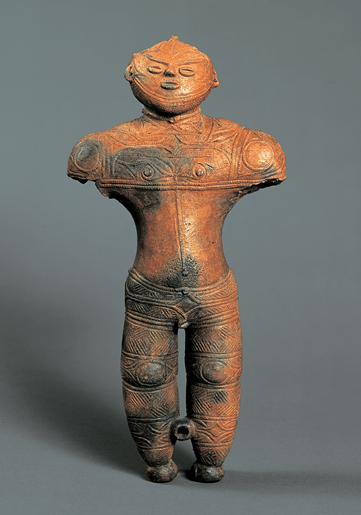
(Picture5) National Treasure
The Late Jomon period Unearthed from the Chobonaino site, Hokkaido
Dogu6 (Picture6)
Next is the “Dogu with Palms Together.” It is the dogu, which was unearthed from a dwelling, as mentioned earlier. This dogu has not been glued by an adhesive at all. All of parts joined by Jomon people and have come off have been remained as they are. The reason why they have been kept coming off is that their conducts of the restorations of the Jomon period can be clearly seen. The pieces broken obviously in the Jomon period were, at first, glued by asphalt. The condition of it which was dropped at last have been kept as they are. Therefore, the broken pieces newly occurred have been joined, however, the parts the Jomon people joined have not dared to do so. The head, as you can see, is expressed by clay rolls tied up like an arrowhead. It is the baked clay object with a mouth, eyes and a nose. The condition is completely the same as the ears, nose and mouth type clay objects. Although the hand is a delicate matter, and if you have chances to observe it, please look it properly, and I hope you judge if it is palming together in prayer or amen. Because of the posture of standing knees, the female genital organs can be clearly seen from the front as well as the previous one from the Nakappara site. Therefore, it is probably squeezing its hand under the condition of wearing a mask. I understand that expressing the female genital organs indicates the condition of a childbirth, although, not many people think that way. The female genital organs are expressed here if looked from the front. And this dogu also is wearing ornaments like these on shoulders. Although its mouth is the most presentational, it is expressed by the dots impressed around the mouth. Since this type has been unearthed from Iwate Prefecture as a mouth type clay object, I believe this is probably the expression which a mask is worn. It is a very interesting dogu, and I remember the portions with cord-marks were all painted red. And everything is expressed by the portions of black luster and the form of red and black. Also the dogu of the Minamikayabe site, mentioned previously, is painted red in the lower half and black in the upper half. When we see it now, it seems that it is not painted, however, if we see the dogu, we can see, the way of expression in applying lacquers or paints was, in a word, very flashy such as gaudy deep red, deep-black, belts of red and black etc. at that time. Although I think we could not imagine that the Yakushiji Temple of Yamato of today was painted in red, white and green colors until it was restored, it is conceivable that it was the similar flashy color sensation. I understand that this expresses hair tied and filleted like an arrowhead through the hole opened.
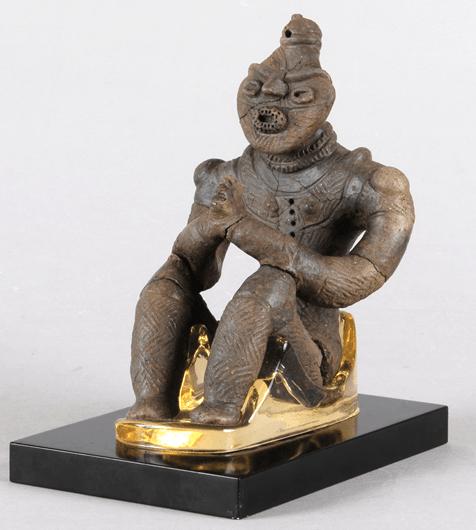
(Picture6) National Treasure
The Late Jomon period Unearthed from the Kazahari 1 site, Aomori Prefecture
Dogu7 (Picture7)
This is a bird, found at the Bibi site, Hokkaido. It has eyes, a beak, wings, and it is looking right against the center line. In a word, it is not looking at the front, but is trying to turn right. The reason is that the left wing is raised and the right wing is lowered. I believe that it expresses an instant form of turning to the right, raising the left side wing. As I mentioned earlier, the two holes have been opened like these.
the side view, it has a mouth, eyes and wings. What the most interesting portions of this clay object are the patterns of a neck at the top and the patterns of a neck at the bottom, and these are the upper section and the lower section. The one between these is a streamlined form. It means that the streamlined patterns are drawn on the portion between these two belts. They have been the streamlined patterns like this from the bottom to the top. If this side is the front, it is the design for receiving winds. This design is exactly the same as one drawn on the airframes of ANA (all Nippon airways) aircrafts. It is the same form as one used in the Jomon period. It is the streamlined form against the flying direction. The one of ANA aircrafts is of exactly the same streamlined at a slant as this. The latest ANA aircraft’s painting designs looks exactly same as the Final Jomon.
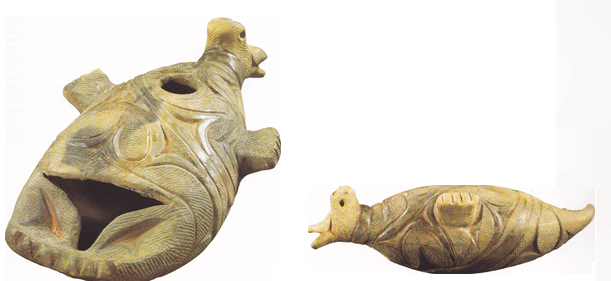
(Pictuire7) The Final Jomon period
Unearthed from the Bibi4 site, Hokkaido
I think these are representative dogu and/or baked clay objects in Japan. I believe you can understand an overall picture of the formation in the Jomon period if the masterpieces of the goggle-eyed dogu or owl-shaped dogu are included among them. And I think you can study that the Jomon dogu have been very elaborately produced, considering the one-time-only nature on the production of baked clay objects as well.
Explanation of Dogu
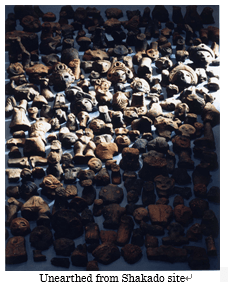
Clay doll in the shape of human in the Japanese Archipelago is called Dogu.
Dogu had been started to be made at same time of the Japanese earthenware (Doki).
But Dogu was getting outdated with the growing rice had been brought to Japan in Yayoi period. Therefore Dogu is characteristic of Jomon and most valuable spiritual relics of Jomon period.
I consider the of the earthenware is that of the Jomon period.
Line carving of the human on the gravel was existed at the beginning of the Jomon. The model carved on the gravel is obviously woman because of the depiction of the breast.
At the beginning of Jomon, there were two ways of using stones or clays. Both ways can describe human, but the two difference materials are used too different way. One hand, the way of using stones, human figures or images were drew or carved again and again on the stone itself. On the other hand, the way of using clay, the figures is unchangeable.
The using two different material has notable features, “Stone-=repetition”, “Clay=one time only”.
As for the person expression, Dogu made from Clay became a main current ever since.
In short, the use of Clay was getting more popular and selective than the use of Stone, the way of the carving lines on the stone was vanishing after all. Making Dogu means “making only one and unchangeable thing “.
The oldest Dogu in Japan was found in the Kayumiijiri site. The Dogu is a flat board and the breasts represent it is female. Same representation is used on the line carving, there is no doubt that Jomon people used the breasts to symbolize female. It was a basic style that they did not describe the face for the first time.
They started to describe the face and to put some stone or gravel on each part of the body at the Early Jomon.
The Dogu which was Hanjyo (a form of a flat board) naturally did not stand on the ground.
The Hanjyo Dogu would become Ritsuzo (standing figure) at the Middle Jomon.
There are 6 ways of how to let Dogu standing which shows on picture 8. Originally Dogu had been shaped with a lump of clay called “Chujitsu” type, after the appearance of the standing Dogu type, Chuku –Dogu (it is hollow inside) had been starting to create. 2 Basic types of “Chuku” and “Chujitsu” type had become established and continued to be used. The most famous Chuku Dogu is “Shakouki (Google- eyed type)” Dogu which was created at the Last Jomon. Shakouki Dogu has the distinctive big eyes on which the line is drawn
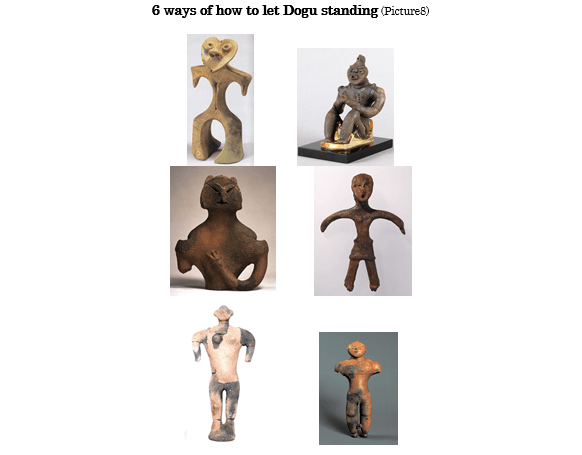
at the center. It is considerate that the closed eyes described “death”. Some ways of how to let Dogu standing all over the Japanese Archipelago indicate that it had not come from one specific area.
After people from any numbers of area got information of the action to let Dogu standing, they try to make it with several and different ways. It obviously shows the Japanese Archipelago was not uniformed. It cannot be proven that the motive for producing Dogu is not the same through the Jomon period.
The characteristic of Dogu is that the body part of female was emphasized at the Beginning of Jomon, and that a pregnant-looking was emphasized at the Middle Jomon, and that the death was emphasized at the Late Jomon. A Dogu which a lot of combs are placed on head was excavated from the Fujioka Jinjya site in Tochigi Prefecture. The buried people whom the combs are placed on the head were found from the grave of Karinba site in Eniwa city about 1000km away from the Fujioka Jinjya site. It looks similar way of the Dogu of the Fujioka Jinjya site. This discovery obviously shows that some Dogu had been described the costume of the dead people to be buried to the graves.
Dogu were produced for several purposes and not in same circumstances in Jomon period. Dogu which have completed body had not be found till 1980’s, even more that 1000 pieces were found in one time at the Shakado site of Yamanashi Prefecture. It is the established theory that Dogu was produced to be destroyed in Japan. Dogu has complete body was found from the grave in Nagano Prefecture.
These Dogu were produced at mostly same time with the result of academic investigation.
And, the Dogu broken to 4 pieces was tidily restored with natural asphalt and red painted was found from the dwelling site in Aomori prefecture.
Dogu is the figure which was not produced with only one motive but produced with various reasons and various purposes throughout the Jomon period.




